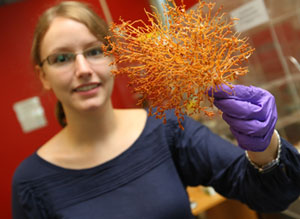 |
| Dal graduate student Lindsay Beazley with Acanella arbuscula, a deep-sea coral. (Nick Pearce Photo) |
Acting as their eyes, a team of 27 Canadian and Spanish researchers used a remotely operated vehicle (called ROPOS) deployed from the Canadian Coast Guard Ship Hudson to dive to the bottom of the sea. They explored exotic-sounding places in the northwest Atlantic, including The Gully, a marine canyon at the edge of the Scotian Shelf, the Flemish Cap, Orphan Knoll and Tobin’s Point. The farthest point was located about 600 kilometres east of St. John’s, Newfoundland.
SEE PHOTOS: A strange and beautiful world
Just off the ship earlier that morning and still feeling the waves after 20 days at sea, the scientists presented their findings for a roomful of journalists at the Bedford Institute of Oceanography in Dartmouth.
‚ÄúWe‚Äôre so excited to let people know what we‚Äôre doing,‚ÄĚ says Ellen Kenchington, coordinator for the 2010 scientific expedition.
 |
| The ROPOS arms take a sample of deep-sea coral, bag it and tighten the drawstring. (Photo courtesy of Lindsay Beazley) |
Overall, eight new species of coral were discovered as well as two sponge species, including a delicate ‚Äúglass‚ÄĚ sponge and a carnivorous sponge. Using the ROPOS, they were able to get pictures and video of the marine species in their habitat and take samples.
Lindsay Beazley, 24, was one of the researchers who went to sea. A master‚Äôs student of biology at AVĺ„ņ÷≤Ņ, she‚Äôs interested in the sex life of Acanella arbuscula, a deep-sea coral common to the North Atlantic. Her inquiry is into whether the coral is a ‚Äúbrooder‚ÄĚ or a ‚Äúbroadcast spawner,‚ÄĚ and the answer will provide insight into the population dispersion of this deep-sea coral through the ocean.
The Sackville, N.S. native first got interested in underwater worlds as a preschooler watching The Little Mermaid. She remembers being entranced by the colour and diversity of life depicted in the Disney movie.
‚ÄúIt‚Äôs still fascinating to me. Being out there, you feel like an explorer. Like these little egg cases from another animal found on the coral,‚ÄĚ she says, pointing out tiny transparent globs clinging to a branch of Acanella arbuscula, one of the samples collected by the submersible robot. ‚ÄúThis is the first time I‚Äôve seen this. It may be the first time anyone has seen this.‚ÄĚ
Corals, forming colonies of tiny invertebrate animals, are the habitat for other marine animals. They are vulnerable to trawling of the ocean floor since they are fragile, long-lived and slow to recover, says Dr. Kenchington, adjunct professor at AVĺ„ņ÷≤Ņ and research scientist at the Bedford Institute of Oceanography.
Sponges, too, are important sea creatures. ‚ÄúThey‚Äôre like the trees of the oceans,‚ÄĚ she adds, dashing off to another interview. ‚ÄúThey filter the water, modify currents at the bottom, provide shelter and increase habitat complexity ‚Ķ there‚Äôs so much more we‚Äôd like to learn about them.‚ÄĚ
